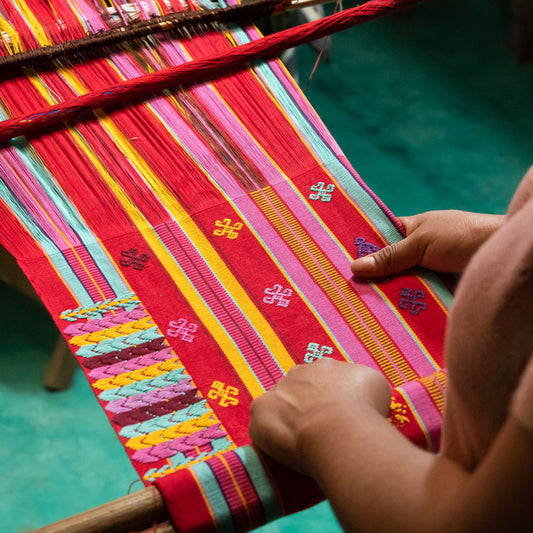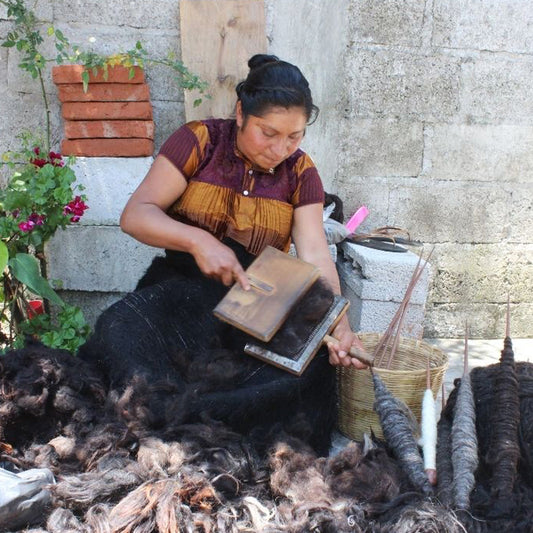Felicity is the founder of the luxury ethical homeware brand Daughters of Gaea. Combining her love of art and interiors with a passion for preserving handcraft techniques, Daughters of Gaea was born out of a desire to create unique and thoughtful homeware with values that reflected her own. Something, she realised, that was difficult to come by.
In this interview, Felicity talks about the inspirations behind her beautiful designs, the (less spoken about) challenges of the fast homeware, and shares the key factors she thinks about when furnishing her home.

Can you tell us little about your story and how Daughters of Gaea was born.
Having completed a Classics degree at university and going straight into a career in finance, my background could not be further from design! However, design has always been a big part of my personal life. I have always been interested in art, fashion and design, and this passion grew the older I got and I became obsessed with home decor and interior design. I think the best and most wonderful aspects of life revolve around art forms and I became really passionate about wanting to channel my style and creativity into something that was my own.
The idea for Daughters of Gaea came when I was furnishing a house a few years ago. When I was looking for pieces to buy, I wanted them to be both ethically made and environmentally friendly. It was only then that I began to realise just how difficult it was to find items that uphold these values, so I started to think about how I could create my own brand, blending these ideas together. I discovered that I could make the most impact if I worked with female artisans in developing countries in an ethical way, creating high-end design, sustainable, homeware.
I think furnishing our homes with beautiful items is easy, but finding pieces that have nothing to hide is much harder - transparent ethical values are unusual in high-end design, and I had scarcely seen it done properly in the luxury homeware space, so this business model inspired me.
From a design perspective, I love discovering new designs, but so much of what you see out there feels like the same recycled ideas. Something truly high-end should have the wow factor of feeling thoughtful and unique. High-end homeware should be timeless, impeccably designed and made to last. I really liked the challenge that came with trying to design pieces that fit this bracket.
"I think furnishing our homes with beautiful items is easy, but finding pieces that have nothing to hide is much harder."
Your collections are rooted in traditional craftsmanship. Why is it important to you that we preserve and celebrate handcraft techniques?
Hand working is the second-largest global employer of women. In a world where industry shuts so many doors to women, it’s a vital economy, contributing $718BN in value to our global GDP. Yet the implementation of social economic protections for women can often be the exception rather than the norm. When brands and artisan businesses come together, we can harness the massive potential of craft to drive economic opportunity for workers everywhere. This can provide a place of safe employment in countries where it’s needed most. And most handcraft techniques can be worked on without the need for any electricity. This means in very rural areas around the world, it can be a way to produce income when there are little other means.
Besides the social and economic benefits, handcraft techniques are beautiful and deserve to be celebrated. When you watch an artisan block printing or intricately weaving on a loom or embroidering some fabric, you see how much skill goes into it. Unfortunately, factories and machines and the need for everything to be produced faster and faster are causing hand-craft techniques to die out, but we want to preserve them as so much love or “prana” goes into an object made with an ancient technique that has been passed down from mother to daughter through generations.
"Handcraft techniques are beautiful and deserve to be celebrated. When you watch an artisan block printing or intricately weaving on a loom or embroidering some fabric, you see how much skill goes into it"
Can you tell us more about your decision to work with female-led artisan groups and how you go about creating these partnerships?
The Daughters of Gaea brand ambition is to have a diverse portfolio of collections, crafted from a variety of techniques by artisan groups around the world. We want to celebrate and uphold community and preserve handcraft traditions.
There are so many different techniques and heritage cultures in the handcraft industry that come from all over the world, so I decided to work with NEST, a charity who works with artisan collectives around the world to ensure ethical compliance of artisan workers. The work NEST does, partnering designers with artisan groups that they oversee, enables designers and brands who want to work with fair trade guidelines to find hand workers to make their collections. NEST recognised and also informed me that 95% or more of their workers in their directory in almost every country in the world are women and how handcraft is a vital economy for female employment. It made sense to me to take this a step further and work with artisan groups who also had female-founders. Working with NEST has ensured that there is an extra layer of protection, allowing Daughters of Gaea to have a truly successful social impact with the artisan groups we work with.

How and where do you find inspiration for your designs?
Many of the designs in the collection are directly inspired by the natural world. In my free time, I love to be out in the wilderness, hiking in mountains, wild swimming, walking around gardens.
On my adventures, one of the things I began to notice is that if you take a snapshot of the landscape at any one point, you get a beautiful and unusual colour palette with all sorts of clashing colours infused together to make a striking canvas. This was the inspiration for my first collection. I wanted to create a sense of the rich landscapes you see in nature, taking inspiration from the sky, sea, land, animals, plants and trees. For the India Collection, the clashing of patterns and colour give the designs a sense of untamed, wild landscapes.
As an ethical and sustainable brand, designs based on this philosophy seemed to tie in perfectly with the sustainable materials and low impact dyes we use, sourced directly from nature. This way, we can work in harmony with the land and its people.
My design inspirations for the business are based around the concept that the earth gives us all we need, and it is our duty to respect and honour that. I think in every collection, you will see inspiration from nature. But also ideas based on design traditions from the country the product was made in. For example, the design style of The India Collection pays homage to traditional Indian florals, inspired by a wild garden with repeating, mesmeric patterns.

What do you think are the key challenges the homeware industry needs to overcome?
The homeware space is very fragmented which I think is good and bad for where the industry can move as a whole. On the one hand, there aren’t so many large key players that are leading the way, setting examples of how to run a business in the right way for other brands to look at and follow suit. We have seen this in the fashion industry – lots of brands at the top have been highly scrutinised for unethical practices – e.g. luxury brands burning their stock or Nike being called out for using slave labour. I think this scrutiny has been useful for the fashion industry as it has taught lessons on what not to do and the stakes are now higher to not get things wrong. This starts to put a stop to greenwashing and has started a bigger movement to boycott fast fashion over the last few years which is working, as we see brands like Misguided shutting down.
The problem is, there is less scrutiny on sustainability and ethics in the homeware sector than in fashion because it is less developed. However, it does leave room for smaller players to come in and be that ideal brand with values that other businesses want to follow. I think having a fragmented market means that there is a lot more room for independent smaller brands to succeed. People don’t necessarily know where to go to find their homewares at the moment, or have go to brands that they are loyal to in the space as labels matter less. So marketplaces like Akojo are brilliant for people wanting to find newness and support independent brands.
"When brands and artisan businesses come together, we can harness the massive potential of craft to drive economic opportunity for workers everywhere."
When choosing homeware pieces for your home, what are the key things you think about?
I love supporting independent brands as I feel like I am getting a unique treasure of some sort that barely anyone else will have seen! I’m also obsessed with colour and pattern – neutral is not really my style, so whenever I see a new patterned design or something that looks totally original, I get really excited.
I think that you can display such a sense of your own taste and style through your home – maybe even more so than fashion as you don’t have to worry about things fitting or looking right on you. I would also always make sure that I am buying from a brand who takes their ethical values and sustainability seriously too – that is non-negotiable.
I think that overall my style is quite whimsical, but still high end and chic with a focus on inventive design style. I love being in nature, so my ideal home would be a traditional countryside cottage with a modern, contemporary interior, not too cluttered or chaotic, but filled with colour and pattern.
What plans do you have for the future of Daughters of Gaea?
I recently created a new linen collection of twelve cushions made from 100% organic linen which will be launching at Decorex in mid-October! I wanted this collection to be an extension of The India Collection, but with a more contemporary style, playing with the way that blocks can be arranged for printing in abstract shapes.
I am always thinking about new ideas for collections and have just begun working on The Mexico Collection which is being sewn by a wonderful women’s embroidery collective in Oaxaca. Taking inspiration from Mexico’s fascinating spiritual roots, the designs of this collection will use elements representing spirituality, astrology and otherworldliness. This collection will be launching late 2023.
Besides that I am planning an exciting collaboration of Kaftans with a very well known homeware brand which I hope to launch at the start of 2023.
I would also love to do a weaving collection made in Peru and a Shibori dying collection made with a group in Africa. The hope for Daughters of Gaea going forwards is that I have multiple collections celebrating a variety of handcraft techniques from different countries all around the world.




